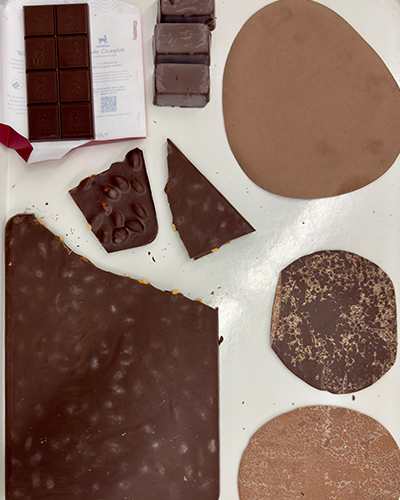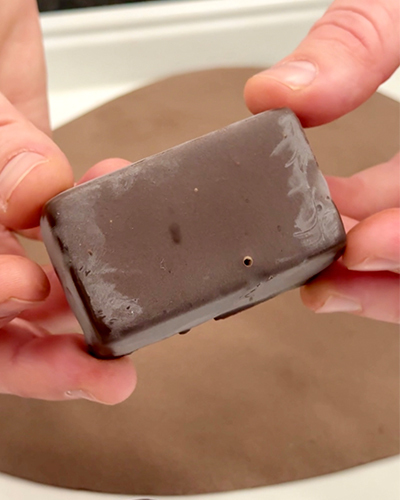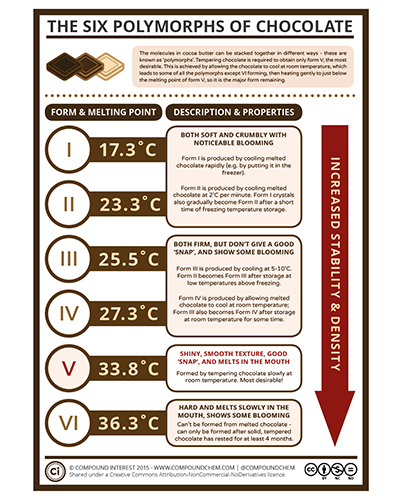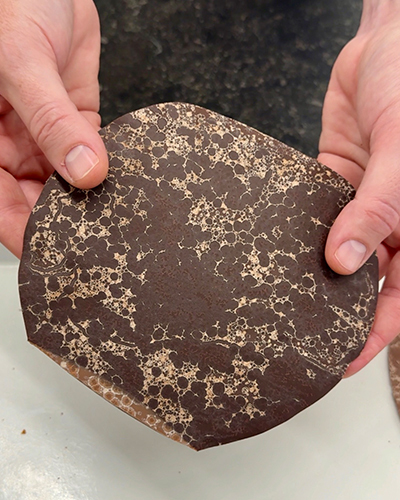
What is Chocolate Bloom?
Have you ever opened a chocolate bar to find it covered in a whitish-grey haze? That's called chocolate bloom and it happens when your chocolate wasn’t well-tempered or when it experiences big swings in temperature or humidity. This allows the sugar or fat crystals in the chocolate to “bloom”, or rise to the surface, leaving a greasy white residue, a discolored appearance, and it changes the texture of the chocolate. While it is still safe to eat, chocolate bloom is preventable.

Examples of different kinds of chocolate bloom.

Chocolate with sugar bloom.
What is sugar bloom?
There are two different kinds of chocolate bloom: sugar bloom and fat bloom. Sugar bloom is caused when chocolate is subjected to high humidity or condensation. The sugars in the chocolate absorb the excess moisture. This draws the sugar to the surface of the chocolate. Then, when the moisture evaporates, the sugars re-crystallize into a grainy, dusty layer on the outside the chocolate.
What is fat bloom?
Fat bloom occurs when chocolate experiences a drastic change in temperature. The cocoa butter in chocolate melts and separates from the other ingredients. The fats travel to the surface of the chocolate and cause a whitish gray residue that feels greasy and leaves the chocolate crumbly. Fat bloom can also happen when other fats, like the oil in a peanut butter filling or the oil from a nut, migrate to the surface of a confection.

A chocolate bar with fat bloom.
What causes chocolate bloom?

Hang on while we get a little technical. To truly understand what causes the most common chocolate bloom, you need to understand some of the fundamentals of chocolate. Chocolate is made from two main ingredients: cocoa powder and cocoa butter. Cocoa butter is made up primarily of fat molecules. How these fat molecules are arranged or structure together directly affects the resulting texture of the chocolate.
Scientists have found that cocoa butter has at least six different structures or crystal forms. Chocolate is tempered by heating, cooling, and keeping in constant motion, to create the ideal stable crystalline structure (form V). This crystalline structure gives chocolate its shiny, smooth texture, good snap, and melt-in-the-mouth properties we love. When cocoa butter experiences a change in temperature, this crystalline structure begins to change, and fat bloom occurs.
Is it safe to eat chocolate bloom?
Bloomed chocolate, while it doesn’t look particularly appetizing, is completely safe to eat. But, just because you can, doesn’t mean that you want to. Bloom is an indication that the molecular structure of the chocolate has changed. This means that instead of having the ideal chocolate texture that we all know and love (a clean snap and lustrous shine), bloomed chocolate is often powdery and crumbly.
How do you prevent chocolate bloom?
At Lake Champlain Chocolates we work hard to ensure our chocolates are properly tempered. Well-tempered chocolate is more resilient against changes in environment (such as changes to humidity and temperature). That being said, high temperatures or condensation will bloom even the most beautifully tempered chocolate! Chocolate that’s poorly tempered may look ok for a short time, but will bloom quickly even in ideal storage conditions.
Proper storage can prevent chocolate bloom. It’s always best to store chocolates in an airtight container in a cool, dark, dry place. Avoid storing your chocolate in the fridge or freezer as the drastic changes in temperature can cause condensation to form and ultimately cause sugar bloom. The cocoa butter in the chocolate also absorbs odors like a sponge. Putting your chocolates in the fridge can cause them to smell (and taste) like anything else you might have in there (like onion). If you must refrigerate it, wrap it airtight to avoid odors, and let it come to room temp while still wrapped to protect against condensation.

Chocolate bloom caused by condensation.
What to do if your chocolate has bloomed?
Don’t throw out your bloomed chocolate. While it is 100% safe to eat chocolate that is bloomed, it will not have the ideal taste and texture. Instead, of discarding the chocolate, chop it up to use it in your favorite Chocolate Chip Cookie, Brownie, or Chocolate Mousse recipe.